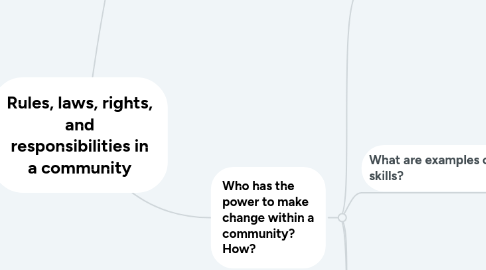
1. Who makes the rules? Why do we have them?
1.1. The difference between rules, rights, and responsibilities
1.1.1. Engagement: Read aloud "What if Everybody did that?" (Javernick, 2010)
1.1.1.1. Pre-assessment: draw, write, and/or provide an example as definitions for the following words: law, rule, right, responsibility
1.2. How are rules similar or different from laws?
1.2.1. How are laws made? Who makes them?
1.2.2. The Constitution of the United States of America
1.2.3. Classroom "Constitution"
2. Who has the power to make change within a community? How?
2.1. What communities do you belong to? What are the rules, rights, and responsibilities within those communities?
2.1.1. Students will, with a partner or group, complete a KWL chart (writing or drawing) about anything at all about communities, personal communities they belong to
2.1.1.1. Engagement | Foster Collaboration and Community 8.3 (CAST, 2018)
2.1.2. To form connections to their learning and each other, students will do an energizer called "Just Like Me!" (Responsive Classroom, 2020). The teacher will read statements about known communities that her classroom belongs to; statements will include whole class communities as well as unique and personal ones (all in 2nd grade, fans of the song 'High Hopes', players of basketball, etc.)
2.1.2.1. Engagement | Foster Collaboration and Community 8.3 (CAST, 2018)
2.2. What are examples of civic values and skills?
2.2.1. Book: "What can Citizens do?" (Eggers, 2018)
2.2.1.1. Read with a partner, listen to the video of Srta. Major reading, or read silently to self.
2.2.1.1.1. Representation Offer alternatives for auditory (1.2) and visual (1.3) information (CAST, 2018)
2.2.1.2. Graffiti protocol (Hollie, 2018); write, draw, talk with a team as you move from poster to poster interacting and connecting with different civic abilities.
2.2.1.2.1. Representation Support decoding of text (2.3), Guide information processing and visualization (3.3), Maximize transfer and generalization (3.4) (CAST, 2018)
2.3. Famous change-makers
2.3.1. Students will choose from pre-selected famous change-makers and determine their civic qualities, their impact on their communities, and the road they took to get there. The teacher will provide graphic organizers and templates for organizing information. The students will present their famous person in a way of their choosing (presentation, speech, video, art, etc.)
2.3.1.1. Action & Expression Facilitate managing information and resources (6.3) (CAST, 2018)
2.3.1.2. Engagement Optimize relevance, value, and authenticity (7.2) (CAST, 2018)
2.4. YOU as a change-maker
2.4.1. Think about a law, rule, right, or responsibility you might like to change. Which of the above is it classified under? You may also use one of the ideas below. Why does it call for change? What process do you need to follow to change it? Self score using the provided rubric and self-reflection survey.
2.4.1.1. Action & Expression Enhance capacity for monitoring progress, use of scoring rubrics, self-monitor and self-reflect (6.4)
